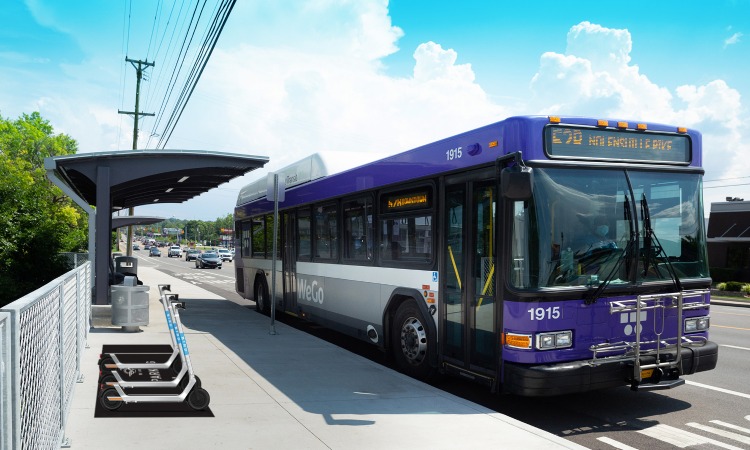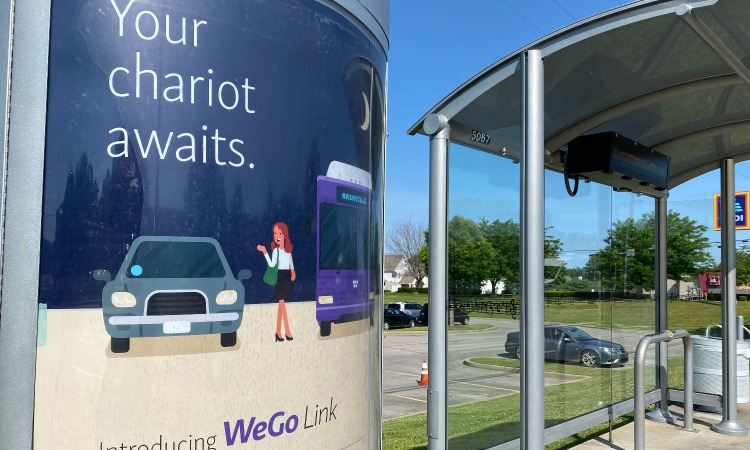Bridging transit gaps in Nashville with public transit and micro-mobility integration
- Like
- Digg
- Del
- Tumblr
- VKontakte
- Buffer
- Love This
- Odnoklassniki
- Meneame
- Blogger
- Amazon
- Yahoo Mail
- Gmail
- AOL
- Newsvine
- HackerNews
- Evernote
- MySpace
- Mail.ru
- Viadeo
- Line
- Comments
- Yummly
- SMS
- Viber
- Telegram
- Subscribe
- Skype
- Facebook Messenger
- Kakao
- LiveJournal
- Yammer
- Edgar
- Fintel
- Mix
- Instapaper
- Copy Link
Posted: 31 May 2022 | Dan Freudberg - WeGo Public Transit, Justin Cole - WeGo Public Transit | No comments yet
WeGo Public Transit’s Dan Freudberg, Deputy Chief Operating Officer for Operations Systems, and Justin Cole, Senior Transit Planner, speak with Intelligent Transport’s Halimah Haque about the agency’s recent partnership with micro-mobility operator Bird, as well as the significance of adopting multimodal transportation to bridge first- and last-mile transit gaps in Nashville.


Credit: WeGo Public Transit
What impact will WeGo Public Transit’s partnership with micro-mobility operator Bird have on the public transport sector?
Dan Freudberg: We see partnerships with micro-mobility providers such as Bird as opportunities to expand our role from solely a transit service provider to a mobility co-ordinator. There are many service options and alternatives to single occupancy vehicles now available to the public, in addition to traditional bus and rail transit. We acknowledge that our services may not meet the needs of every customer for every trip, and that is why we are eager to find partners that help to address challenges such as first- and last-mile connections.
While we continue to see fixed-route transit as the backbone of the public transportation network, augmenting that network with alternative services where appropriate and available is beneficial to all”
While we continue to see fixed-route transit as the backbone of the public transportation network, augmenting that network with alternative services where appropriate and available is beneficial to all. We want to make multimodal trip discovery and planning easier through these and other partnerships, whether that be through fare incentives, technological integration, or planning in the deployment of services. In this case, with Bird, we’re starting with a pilot that primarily involves service planning co-ordination, but this could certainly evolve to more complete service integration in the future.
How will this partnership help to bridge first- and last-mile transit gaps in Nashville?
Freudberg: Nashville is a notoriously un-walkable city. While the Nashville Department of Transportation (NDOT) has made great strides in recent years, there are still many streets and neighbourhoods without adequate pedestrian infrastructure. Many areas were built up without sidewalks or crosswalks, and it is much harder to go back now and try to address decisions that were made in the past with regards to these types of facilities.
In the long term, WeGo Public Transit is very much supportive of creating a more complete street network that better accommodates other modes of travel aside from the car, but we understand that it will take time to get there. Partnerships with micro-mobility providers allow us to do something now that can help provide another option for those that want to ride the bus. In addition, even in areas where sidewalks are prevalent, the distance to the nearest bus stop may be an impediment. This type of partnership effectively extends the range at which transit is convenient from half a mile to perhaps two or three miles.
Partnerships with micro-mobility providers… extends the range at which transit is convenient from half a mile to perhaps two or three miles”
The programme is also very much complimentary to other first- and last-mile solutions, including our partnership with Uber for ride-share connections to transit in the Antioch area of southeast Nashville. Through that programme, called WeGo Link, customers receive a discount on their Uber trip, provided that their trip is within the designated programme area and starts or ends at one of two designated transfer locations to our frequent transit service on Murfreesboro Pike (Route 55).
Why is it so important for these transit gaps to be tackled?
Justin Cole: Over the past few years, WeGo has been able to add frequent bus services on many of the major pikes connecting outer neighbourhoods to downtown Nashville. These frequent routes keep waiting time to a minimum, helping riders reach their destination quickly without needing to check a schedule. However, particularly further from Downtown, many residents are still beyond comfortable walking distance of a bus stop. While growth along major corridors continues, there is still a large portion of Nashville’s population living in lower density areas that can’t easily be served with frequent fixed-route transit. This makes first- and last-mile connections to those frequent corridors a particularly important tool to help WeGo serve as much of the city as possible.
There is still a large portion of Nashville’s population living in lower density areas that can’t easily be served with frequent fixed-route transit. This makes first- and last-mile connections to those frequent corridors a particularly important tool”
Bicycles and scooters offer an opportunity for WeGo to extend the coverage of the existing fixed-route network by expanding access to transit deeper into residential areas. This provides benefits to the residents of Nashville by making transit a more feasible option for a wider variety of trips. Most riders that access transit by walking, walk less than half a mile. While some may be willing to walk a little further, the additional distance and time makes that less desirable for many existing and potential riders. However, a scooter or bicycle can turn a 20-minute walk into a four- to five-minute ride. Expanding access to service in this way also provides benefits to WeGo by leveraging existing investments in the frequent transit corridors. Getting more riders on those corridors where frequent service already exists helps improve productivity and increase fare revenue that can be reinvested into additional service improvements in the future.
How significant a role did data play in identifying the community’s current transit gaps, and will this data continue to support future decisions?
Cole: For the partnerships with scooter companies, WeGo used stop-level boarding activity to identify high ridership stops along frequent corridors outside of Downtown. In many cases, these stops were near major trip generators or destinations. They also often had other amenities such as sheltered waiting areas and benches that would support multimodal connections. In addition to ridership, WeGo considered whether there were low-density areas adjacent to these stops that are not directly served by transit. This put scooters in areas where demand was known to exist, but also where there was significant opportunity to serve new riders and destinations, and to fill gaps in coverage.
Low-income, minority, and zero or single car households are all more likely to use transit. By focusing on places with higher concentrations of these demographic groups, WeGo works to help improve social equity”
Another important factor considered when planning any first- and last-mile services is demographics. Low-income, minority, and zero or single car households are all more likely to use transit. By focusing on places with higher concentrations of these demographic groups, WeGo works to help improve social equity, while also prioritising areas that are most likely to generate more ridership.
In the coming years, the agency hopes to learn from these initial pilots to continue to refine and improve connections between buses and scooters. By observing trends in the use of both scooters and transit, WeGo hopes to identify how people use scooter and transit together and where connections between the modes work best. We have already participated in a study with researchers from the University of Tennessee looking into this topic.
Continued availability of data will be critical to future planning. Overall, a better understanding of how these modes can work together will help us prioritise supportive service and infrastructure improvements.


Credit: WeGo Public Transit
What contribution will this partnership have towards WeGo’s efforts to provide sustainable modes of transport and encourage modal shift?
These trips are part of a mobility landscape that helps move the city toward a more sustainable transportation system… The more that people can (and choose to) take fixed-route transit, the more efficient each bus trip becomes”
Freudberg: Any travel option that has the potential to reduce single-occupancy vehicle traffic on Nashville streets serves to increase the sustainability of the transportation system. In this case, electric scooters have a very low-carbon footprint relative to vehicle traffic. However, even in cases where larger vehicles are used for first- and last-mile connections, such as the WeGo Link partnership with Uber, given that most of the trip is still being taken on fixed-route transit rather than a personal vehicle, that trip is almost more efficient from an energy consumption and environmental impact perspective.
For riders that are already within walking distance of transit, scooters and bicycles can provide another option for how they can access transit that reduces total travel time. To the extent to which this encourages them to take transit more frequently, that can help reduce the overall environmental impact. These trips are part of a mobility landscape that helps move the city toward a more sustainable transportation system where transit plays a larger role in how people move around Nashville. And the more that people can (and choose to) take fixed-route transit, the more efficient each bus trip becomes.
Is the future success of public transport, both within Nashville and more generally, going to be driven by multimodality?
Freudberg: To a large degree, multimodality has always been a defining feature of a transportation system that includes public transport. Nearly every fixed-route transit trip starts with a walk to the bus stop and ends with a walk to the ultimate destination. We are just looking at additional options beyond walking that allow more people to access transit. Especially in an area such as Nashville that doesn’t have high-capacity rapid transit such as a subway, we have to do everything reasonable to make transit as convenient as possible.
While a trip on transit in Nashville is rarely faster than driving a car, efficient first- and last-mile connections can ease barriers to access while lowering the overall time it takes to take a trip”
While a trip on transit in Nashville is rarely faster than driving a car, efficient first- and last-mile connections can ease barriers to access while lowering the overall time it takes to take a trip (by reducing the time spent walking). In parallel, we are also looking at ways to speed up the transit leg of the trip through things like transit signal priority and (hopefully) future bus lanes, but just like sidewalk infrastructure, those are not overnight solutions to implement. The trips that will benefit from this particular type of partnership will always represent a relatively small percentage of overall ridership, but this service is still important in building out a complete transportation network that meets the travel needs of more Nashvillians.
What future projects does WeGo have planned to encourage public transport use in the region?
Cole: WeGo is currently implementing its Better Bus Plan, which aims to improve the existing bus network in Nashville by investing in:
- More frequent service to shorten waits and get riders to their destination faster
- Earlier/later service to make transit useful and available for a wider variety of trips
- Better evening and weekend service to support all-day, all-week travel
- New crosstown connections to make it easier to travel without going Downtown
- Better access paratransit service for disabled riders.
After some service reductions during the pandemic, WeGo has restored service to above pre-pandemic levels, while shifting resources to best meet changing demand and advance the principles of the Better Bus Plan. Instead of restoring all peak-period, commuter-focused services, the transit agency has prioritised more service in places and times that were least impacted by pandemic ridership declines. This has included upgrading a major route to a frequent service corridor (15-minute or better on weekdays) and improving evening and weekend service. WeGo is also now operating service past midnight, six days a week.
Instead of restoring all peak-period, commuter-focused services, the transit agency has prioritised more service in places and times that were least impacted by pandemic ridership declines”
Another upcoming improvement is the addition of new neighbourhood transit centres outside of Downtown. These facilities provide opportunities for multimodal connections and will allow for more crosstown and connector routes in the future. WeGo just opened the Hillsboro Transit Center in Green Hills and expects to begin construction on the North Nashville Transit Center in late 2022.
Finally, one exciting improvement that has been recently launched is QuickTicket, WeGo’s new fare payment system. QuickTicket allows riders to use either a mobile app or contactless smart card to pay fares. Riders can easily add value to their account, and a new fare capping programme ensures riders always get the best deal by automatically upgrading them to a day pass or month passes once they’ve logged enough rides. The QuickTicket system also lays the foundation for future integrations with other mobility service providers, including shared mobility devices which can make multimodal trips more seamless.




Related topics
Accessibility, Air Quality, Fleet Management & Maintenance, Mobility Services, Multimodality, Public Transport, Sustainable Urban Transport
Related modes
Bikes & Scooters, Bus & Coach
Related cities
Nashville
Related countries
United States
Related organisations
Bird, Nashville Department of Transportation (NDOT), WeGo Public Transit
Related people
Dan Freudberg, Justin Cole







